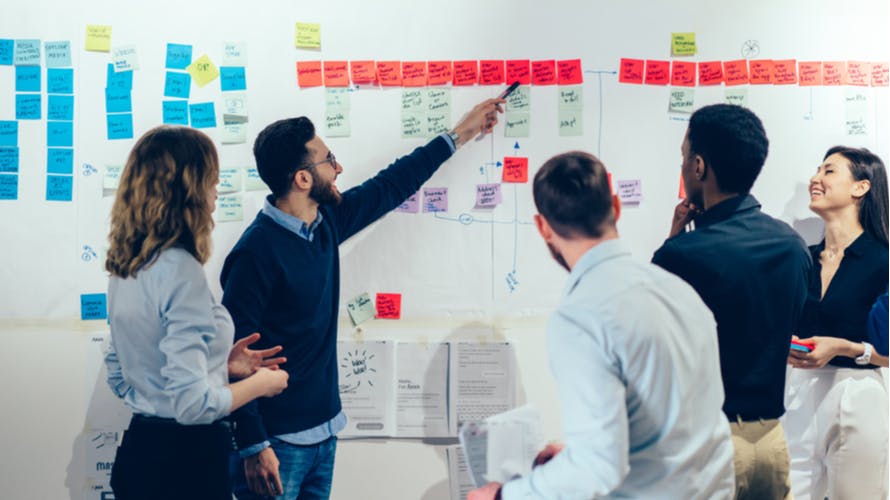Don't Be a Flamingo: Why Co-Design Matters & How to Do it Right

Modus recently completed a series of mobile application prototypes with a large pharma client and some of their top behavioral scientists. The process was highly collaborative from the start — with a full-day work session to kick us off — and it remained collaborative through every stage of the process. We ended up with some exciting concepts that are not only whiz-bang from a UX perspective, but are firmly rooted in evidence-based science. We are testing the prototypes now but early indications are promising.
In reflecting on the work, I realize how important a truly collaborative approach was, and the value of adopting methods and exercises that engage our clients to unlock their expertise and passion to inform the product. This becomes increasingly critical as the complexity of an industry and its core activity increases. In healthcare, where the level of complexity is only matched by the level of risk, co-design is absolutely necessary for creating successful products and experiences.
What is Co-Design?
Like many great design methodologies, co-design (also known as co-operative design or participatory design) was actually born in Scandinavia in the 1960s. Co-design is used in all sorts of fields, from digital product design to architecture to medicine, but always with the same intent: actively involve all stakeholders — clients, partners, customers, users, citizens, employees — in the entire design process to achieve the most useful and usable end result.
I appreciate this quote in describing the true essence of co-designing:
“Driven by desire, participatory design is a ‘collective bricolage’ in which individuals (clients, users, designers) are able to interrogate the heterogeneity of a situation, to acknowledge their own position and then go beyond it, to open it up to new meanings, new possibilities, to ‘collage their own collage onto other collages,’ in order to discover a common project. As in bricolage, in participative projects, the process is somehow more important than the result, the assemblage more important than the object, the de-territorialisation more important than the construction of territories.”
Doina Petrescu, from “Losing Control, Keeping Desire,” in Architecture and Participation, 2005
Keys to Co-Designing Success
So how do you make it work for you and your teams? Here are a few tips and tricks we have learned along the way:
- Start early. We like to kick off projects with a full- or half-day session of collaborative planning, ideation, prioritization, roadmapping, and problem/goal definition with all parties. These sessions can take various forms, but they all include activities in which everyone in the room is an equal participant, the energy level is high, and the work product is shared. It’s a great way to set up a collaborative dynamic from the start that can flow through the project.
- Define clear areas of expertise. In a good co-design environment there are often experts from very different domains at the table, and knowing what context to defer to whom is critical. In the example of our collaboration with the pharma client, we had a lot of UX researchers and the client had a lot of behavior science researchers. Defining what engagement with the digital experience itself was (we called “little e”) and what engagement with the behavioral change technique was (we called “big E”), was an important distinction to define and consistently use as a lens throughout the process.
- Be vulnerable. In the old days, we would meet with the client and get a “download,” go back to the shop, have many internal iterations and reviews, and then deliver highly polished outcomes to the client. Nowadays, we ideally include our clients in all reviews, which at first feels scary to show an emergent, partially formed, potentially off-the-mark creation to the people who are paying you. But getting insights and feedback from the domain experts earlier and maintaining the collaborative flow ends up with better results faster.
- Have fun. It’s a well-established phenomenon that social laughter promotes feelings of safety and closeness in groups. These are exactly the group dynamics required for fruitful co-design, for people to take risks with “crazy” ideas (that just. might. work.) and be vulnerable. While the culture in corporate America, even in large companies, is shifting to embrace ideas like “fail fast” and the value of risk taking, some industries (like healthcare) are slow to adopt these concepts. And when projects encounter challenges, as they all do in some way at some point, it helps to be able to maintain some levity and increase pain thresholds.
Whether it’s achieving better health outcomes or any other goal, designing with clients, users, experts and stakeholders is a key approach to creating successful products and experiences that not only look and work great, but the create a real impact and making a meaningful difference.
So don’t be a flamingo and try to stand on one leg, stand on all the legs you can.

